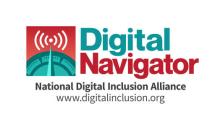
For those in research, policy, community support, and the host of interrelated spaces who are hard at work to make sure that everyone in the country who wants to get online can, expanding broadband is a two-fold problem: that of broadband availability, and that of broadband adoption.
The first of these relates to the problem of making sure that federal and state legislation and the policies that go with them work towards building the infrastructure and creating the competitive markets that result in reliable, low-cost, high-speed Internet access for all. The second of these — broadband adoption — relates to the collection of obstacles that keep people offline even after an Internet connection is available up to their door. Cost remains one of the most problematic, but there are others as well.
The onset of the coronavirus pandemic this year has made overcoming these challenges more important and immediately pressing than ever, and the National Digital Inclusion Alliance (NDIA) has initiated a program to help: one-on-one, phone-based support from locally trained people across a range of digital inclusion services call the Digital Navigator Model.
The concept was developed last April, and the completed Digital Navigator Model, developed by NDIA along with partners and allies, was released this August. Its purpose, from the press release:
The COVID-19 pandemic has created a sudden, massive public need for trustworthy digital inclusion services. Millions of Americans need support from digital inclusion programs: to get connected with affordable home internet, find affordable computing devices, and learn basic digital skills. “Digital Navigators” is an adaptation of traditional digital inclusion programming to this new reality, providing one-to-one dedicated support via phone service.
The idea is to train volunteers and individuals already working in communities (including public library workers and other relevant city staff) across the country to handle the range of barriers that individuals in their communities face to getting online, collect the local resources already in existence, and connect them all via individual phone calls. In NDIA’s words:
A trained Digital Navigator will be able to assess a community member’s need, and competently guide them towards resources that are suitable both for their skill level and lifestyle. Taking into account social distancing, a Digital Navigator can reliably point a community member to online resources suitable to their needs such as online classes or self-guided tutorials.
For communities looking to adopt the model the NDIA has released, among other helpful documents, a sample job description for new staff hires and a worksheet to help map and more effectively tailor solutions. Philadelphia has already adapted its own work to mesh with the model, and Rural LISC and the Salt Lake Public Library are serving as pilot partners. The NDIA has additional documents at its website, but is also available for formal consultation services to help communities tailor the model to local resources and need. They can be contacted here.
Listen to NDIA Executive Director Angela Siefer and Christopher talk about digital inclusion during the pandemic on Episode 405 of the Community Broadband Bits Podcast below.







